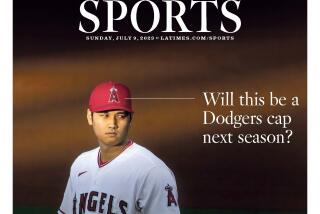Stock, Fund Tables Offer More Data
- Share via
The Times has revised its Sunday stock and mutual fund listings. The aim is to make the data easier to read and more relevant. Among the key changes in the tables, which appear today beginning on C7:
* Type has been made more readable where possible.
* Stocks now are priced in decimals rather than fractions.
* Nasdaq, Nasdaq Small Cap and American Stock Exchange stocks are combined in one table.
* The largest Nasdaq and Amex stocks are highlighted in a separate table with additional data.
* Well-known and Southern California stocks are highlighted in special tables as part of an expanded Weekend Market Roundup page. Included are additional data such as “projected price-to-earnings” ratios.
* Several hundred more mutual funds are now being listed.
* Funds now are organized under a single family name in most cases rather than spread across several class categories such as A, B and C shares.
* The final figure in the fund tables is Morningstar’s “star” rating for fund historical performance. A “5” rating is the top rating. This differs from the Lipper Inc. ratings previously used in The Times’ tables, which used “1” as the top rating.
*
The following are answers to common questions investors may have about the changes.
We are interested in reader reaction to the tables. If you have any questions or comments, e-maildaniel.gaines@latimes.com, or leave a voicemail message at (213) 237-4557.
Question: Why does The Times now publish stock prices in decimals rather than fractions?
Answer: All U.S. stock markets will switch to decimals from fractions beginning in mid-2000. The Times is switching now because many readers have indicated a preference for decimals.
Q: How are mutual fund names now abbreviated?
A: The Times had used mutual fund data from Lipper Inc. in most tables in the past. It will now use data from Morningstar Inc. The two services abbreviate fund names differently. In a few cases, the differences will change the order mutual funds and fund families appear in the table.
For example, the Vanguard Index funds now appear with all Vanguard funds, each beginning with “Idx.” The popular Vanguard 500 fund is “Idx500.”
To allow data on more funds to be published, Morningstar has also grouped most classes of funds under a single family name. For example, Merrill Lynch A, B, C and D funds now appear under a single header, Merrill Lynch.
Also, investors should note that Morningstar places funds managed by T. Rowe Price under “T.” Lipper had placed them under “P” for Price.
Readers may notice other differences as well, including footnotes.
Q: What is Morningstar’s “star” rating?
A: Morningstar, which tracks fund performance, gives a three-year risk-adjusted “star” rating to most major funds. The rating compares a fund’s historical performance with that of others in one of four broad groupings: domestic stock funds, international stock funds, taxable bond funds and tax-free bond funds.
Stars are awarded on a 1-to-5 scale, with 5 being the best. Morningstar uses a bell curve: The highest-rated 10% of funds get a 5, the next 22.5% get a 4, the next 35% get a 3, the next 22.5% get a 4 and the lowest 10% get a 1.
Naturally, the funds in hot sectors such as technology currently have many 5-star ratings, whereas those in cooler sectors have no 5-star funds. The highest-rated real estate fund, for example, currently has two stars.
Note that the previous performance ratings The Times published each Sunday, from Lipper Inc., rated funds on a different scale: In Lipper’s ratings, a 1 was best and a 5 was worst.
Q: What does “risk-adjusted” performance mean, as used by Morningstar to issue its star ratings?
A: Morningstar judges each fund’s overall performance against its historical volatility, including how much the fund declines in down periods. The idea is that you don’t necessarily want to earn the highest returns if a fund is also extremely volatile. High volatility increases the chance of loss if you need to sell at a bad time.
Morningstar therefore believes consistency of performance, as well as above-average performance, is important in judging returns--and whether a fund is a good choice for the typical investor.
Q: What kinds of stocks do you highlight in the Weekend Market Roundup?
A: These expanded tables have more data on the Dow Jones 30 and a selection of other major stocks, on the most active issues for the previous week, and on the biggest gainers and losers for the previous week overall and among Southern California issues.
Q: What are the criteria for deciding what is a “Southern California company” for the new Southern California stock tables?
A: The stocks listed in the Southern California “Gainers” and “Losers” tables are based primarily on companies listed on the major markets that report their headquarters as being in Southern California in official filings.
However, some companies with a significant management presence in Southern California are included even if their official headquarters are elsewhere.
Q: Why do you combine Nasdaq and Amex stocks in one listing?
A: The American Stock Exchange is now a unit of Nasdaq, even though it is a separate marketplace. Also, the number of stocks that trade on the Amex is tiny compared with the number of Nasdaq stocks.
The main issue for investors is whether a stock has met the requirements to be traded on the NYSE, Amex or Nasdaq. The Times does not include in its tables thinly traded stocks on unregulated markets, such as the OTC Bulletin Board or the pink sheets.
The 52-week high and low prices now are shown for the largest Nasdaq and Amex stocks, but not for smaller issues.
Q: What is the PPE ratio?
A: This is a new figure The Times is adding in the highlighted tables for widely known stocks and other stocks in the news.
The PPE, or projected price-to-earnings ratio, is the current stock price divided by the stock’s estimated earnings per share over the coming 12 months. The earnings estimate used to calculate the PPE is Wall Street analysts’ consensus estimate for a particular stock, as compiled by IBES International.
More to Read
Inside the business of entertainment
The Wide Shot brings you news, analysis and insights on everything from streaming wars to production — and what it all means for the future.
You may occasionally receive promotional content from the Los Angeles Times.










